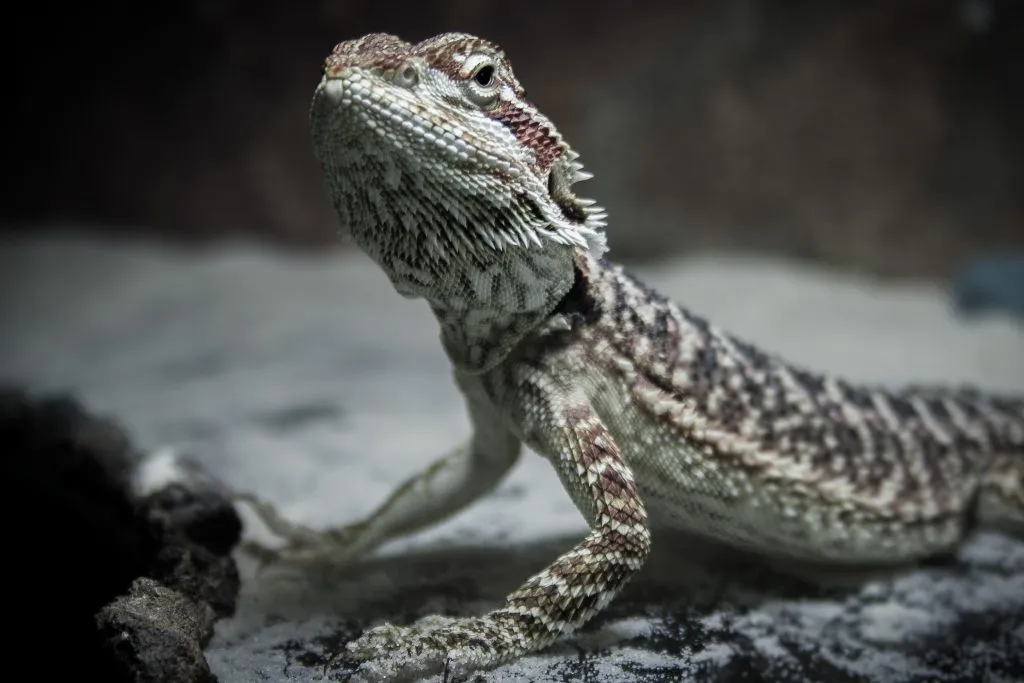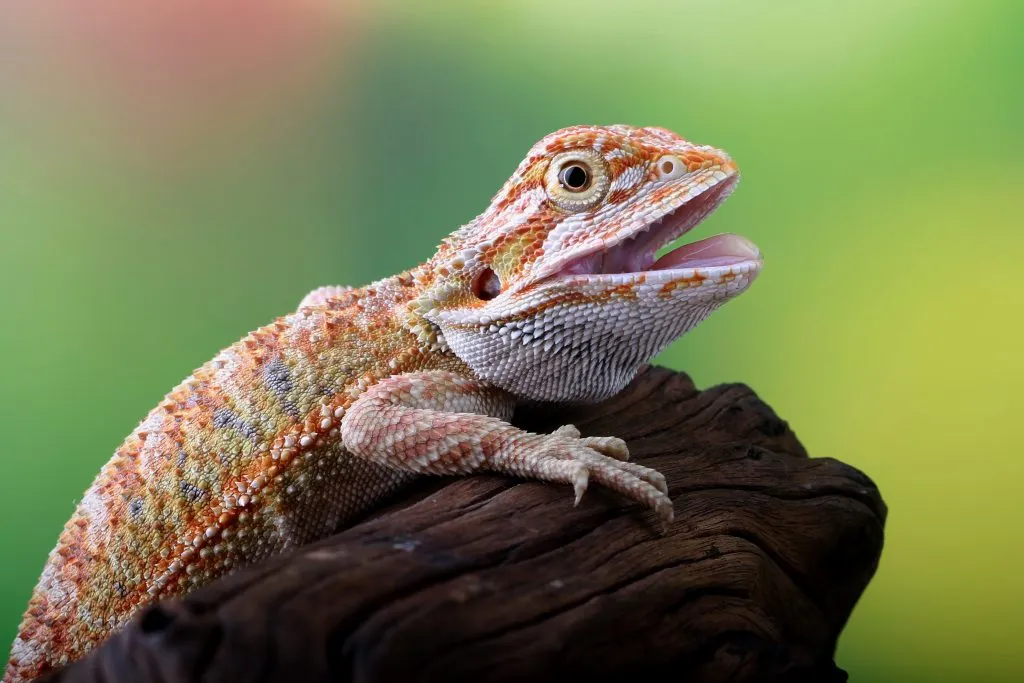
You might find taking a look at your bearded dragon’s poop gross. But you noticed lately that your beardie’s excreting yellow poop instead of its usual brown with white urates. Should I worry about it?
Yellow poop in bearded dragons is commonly caused by high calcium intake, prolonged UVB light exposure, a high beta-carotene diet, and dehydration. Beardies can also excrete infertile eggs and seminal plugs which newbie reptile parents often mistake as yellow poop.
Knowing the meaning behind your bearded dragon’s poop is extremely important. This article will help you decide when a yellow poop is “normal,” what other symptoms you should watch for, and when to consult a vet.
Why is My Bearded Dragon’s Poop Yellow?
Normal poop in bearded dragons is brown in color, log-like in shape, either soft or sem-solid in consistency, and has a white edge. The brown part is the feces (poo) and the white to yellow part is technically the beardie’s urine (pee) called the urate.
This urate should have a pasty consistency and should always be present with the bearded dragon’s poop.
But, if you see more yellow in your bearded dragon’s poop than usual, take a look at the possible reasons below.
1. Too Much Beta Carotene in Diet

Beta carotene is a carotenoid found in orange and yellow-colored vegetables and fruits like squash, carrots, sweet potatoes, and pumpkin.
This serves as a precursor that a bearded dragon’s body converts to the active form of vitamin A.
But unlike the fat-soluble vitamin A, excess beta-carotene does not lead to overdosage. As carotenoids aren’t stored in the liver when there’s too much of it, they’re easily excreted from the body.
Hence the yellow color of their poop.
If this happens occasionally, there’s nothing much to worry about. But if you consistently see bright yellow-colored poop, cut back on the amount of yellow or orange fruits and veggies you’re feeding it.
If the feeder bugs are also eating yellow or orange
Tip: Read our bearded dragon care guide to learn more about beardie diet.
2. Beardie is Dehydrated
The urates (urine component) of your bearded dragons are usually white or yellow-tinged. But, if your beardie isn’t getting the hydration it needs, its feces and urate become more concentrated and become very yellow.
On top of checking its poop color, you can also do a pinch test on your bearded dragon’s skin. Pinch the skin gently on the side part of its body. Skin that goes back quickly in its place means your beardie is well-hydrated.
If the pinched skin goes is sluggish to go back to its original position, it means the lizard is dehydrated. Other warning signs to monitor for include:
- Poor appetite
- Sunken eyes
- Constipation
- Stress Marks
- Black beard
- Lethargy
Take note that every bearded dragon has different presentations for dehydration. If you think your lizard pal is severely dehydrated, bring him to a reptile or exotic animal vet already.
After the vet has rehydrated your beardie, encourage him to drink more. Provide him with fresh and clean drinking water using shallower water dishes to soak in.
If possible, add electrolytes to the water in the soaking dish.
Give your beardie freshly-washed or misted vegetables like salads and some lettuce now and then as they have high water content.
If not, you gut-load his
3. High Calcium Level in the Blood

Calcium is a crucial mineral for reptiles like bearded dragons. Aside from strengthening their bones and preventing MBD, calcium is vital for
- Good muscle contraction
- Proper nerve impulse transmission
- Blood clotting
But too much calcium leads to an overdose called hypercalcemia. Excess calcium in the blood can lead to the following symptoms in your beardie aside from very yellow urates.
| Symptom | Explanation |
|---|---|
| General weakness | • Hardening of the muscles that leads to muscle weakness and soreness |
| Lethargy | • Calcium salts accumulate in the arteries and veins, limiting blood flow to the organs like the brain • This leads to the bearded dragon becoming unresponsive and inactive |
| Poor mobility | • Calcification of the muscles and soft tissues of the beardie which makes movement difficult |
| Dehydration | • Cells lose too much water • The most common reason for beardies to have constipation |
| Renal failure | • Limited blood supply to the kidneys due to accumulation of calcium salts in the renal arteries |
| Liver failure | • Limited blood supply to the liver due to calcium salt accumulation in hepatic arteries |
When this happens, limit or even stop giving calcium-rich foods like leafy greens temporarily.
Make sure to follow the correct calcium supplementation schedule. Whether you’re using liquid or powdered calcium, beardies need certain amounts of calcium according to their age.
| Age | Recommended Daily Calcium Intake | Supplementation Schedule |
|---|---|---|
| Hatchling (under 8 inches in length) | 400-650 mg | Once daily |
| Juvenile | 1,100 mg | Every other day |
| Subadults to Adults | 1,300 – 1,500 mg | Once a week |
Consult a reptile or exotic animal veterinarian first about calcium supplementation for better guidance.
Lastly, don’t cover the entire enclosure with UVB light. UVB light is known to stimulate Vitamin D3 production which helps in calcium absorption. More Vitamin D means more calcium absorbed.
4. Too Much UVB Light Exposure
Bearded dragons need heat and light to produce Vitamin D3. This vitamin helps your beardie absorb calcium better. Hence, in place of the sun, owners place UVB lights in their enclosures.
The problem is too much heat produces more vitamin D3. If too much Vitamin D3 is produced, more calcium will be produced. Hypercalcemia symptoms then appear.
Hence, observe the proper placement of these UVB lights in their enclosure. Don’t cover the entire cage with the UVB light. Your bearded dragon should be able to go in and out of the light as it sees fit.
Also, follow a lighting schedule for your bearded dragon. Avoid turning their UVB lights on during nighttime as this disrupts their sleep.
We recommend Exo Terra Reptile UVB 150 and 5 other best UVB lights for your bearded dragons.
If your concern is maintaining the right temperatures, invest in a heating pad or better yet ceramic heat emitters.
Tip: While heating pads are good supplemental sources of heat, they’re not the safest. Read this article to know where to place heat pads and learn about a safer alternatives.
5. Non-Poop Substances Beardies Excrete that Look Yellow

a) Infertile Egg (Female Beardies)
Female bearded dragons need to breed with a male to lay fertile and healthy eggs. But, sometimes, a female beardie can lay eggs even without mating. This is when the clutch of eggs that they lay become infertile.
Infertile eggs (aka slugs) differ from poop through their shape and appearance. Slugs are yellow-tinted and are deflated with lots of mucus. Poop is more log-like in shape and semi-soft in consistency.
If you notice your beardie laying an infertile egg clutch, don’t pull them. There’s a high chance that it’s bound with another egg inside, and pulling on it could lead to injury.
Instead, place your beardie in a lay bin and offer her calcium supplements. You can try
bathing and massaging her to see if it helps push the slugs out. But if she’s egg-bound,
bring her to the vet immediately for surgical egg removal.
b) Seminal Plug (Male Beardies)
Seminal plugs, aka sperm plugs, appear when the seminal fluid released by sexually mature male beardies accumulates in their hemipenes.
But unlike poop, sperm plugs are usually yellowish-tinged and string-like in appearance
Sperm plugs are considered normal. They may even increase in size and volume during warmer months, corresponding to their mating season.
Usually, beardies can remove these sperm plugs on their own. If after a day or two the plug remains stuck, soak him in warm water while massaging the area around his vent with a wet cotton swab.
Don’t yank the sperm plug. This is very painful and upsetting for the bearded dragon. But, if your beardie finds it hard to poop and has a red and/or swollen area around their vent, bring him to a reptile vet ASAP.
What Other Symptoms Should You Look For Aside From Yellow Poop?

Poop Consistency
Normal poop in bearded dragons should be solid or semi-solid. If your beardie starts expelling rock-hard poop, it means he’s dehydrated.
If the feces start becoming mushy or runny, it can be that he has a parasitic infection.
Tip: Diarrhea can lead to dehydration in your beardies. Learn more about diarrhea in beardies, its causes, and treatments in this article!
The most worrying type of poop is one that doesn’t have any consistency (mostly liquid) with fecal matter in it. This indicates that your beardie is experiencing renal problems.
Bowel Movement Frequency
A bearded dragon having a bowel movement daily up to twice a week is considered normal. Some may even have up twice daily depending on their
If your beardie doesn’t poop for more than 7 days, it can mean he’s constipated or worse, impacted.
Smell
Normal and healthy beardie poop has a slightly pungent odor to it. But if the smell becomes worse and makes your entire house stink, take your bearded dragon to a reptile vet to have him examined.
Presence of Blood in the Poop
Foods that are red or have red pigment can cause your beardie’s poop to appear red, too. But, if you haven’t fed your lizard pal or their feeder insects any red-tinged
If possible, take a fresh sample of the poop and place it in a sterile container for the vet to see. Most likely he will order a fecal analysis to know the reason behind the presence of blood in your bearded dragon’s poop.
- Enchi Ball Python: A Unique and Stunning Morph of Python regius - March 27, 2025
- Emerald Tree Monitor: The Enigmatic Green Guardian of the Rainforest - March 26, 2025
- The Egyptian Cobra (Naja haje): A Fascinating Serpent - March 25, 2025
